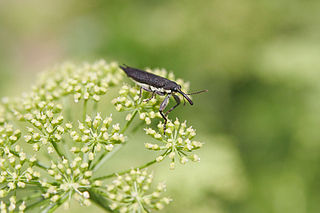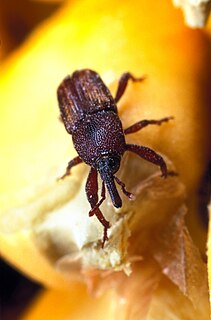Related Research Articles

Beetles are a group of insects that form the order Coleoptera, in the superorder Endopterygota. Their front pair of wings are hardened into wing-cases, elytra, distinguishing them from most other insects. The Coleoptera, with about 400,000 species, is the largest of all orders, constituting almost 40% of described insects and 25% of all known animal life-forms; new species are discovered frequently. The largest of all families, the Curculionidae (weevils), with some 83,000 member species, belongs to this order. Found in almost every habitat except the sea and the polar regions, they interact with their ecosystems in several ways: beetles often feed on plants and fungi, break down animal and plant debris, and eat other invertebrates. Some species are serious agricultural pests, such as the Colorado potato beetle, while others such as Coccinellidae eat aphids, scale insects, thrips, and other plant-sucking insects that damage crops.

The boll weevil is a beetle that feeds on cotton buds and flowers. Thought to be native to Central Mexico, it migrated into the United States from Mexico in the late 19th century and had infested all U.S. cotton-growing areas by the 1920s, devastating the industry and the people working in the American South. During the late 20th century, it became a serious pest in South America as well. Since 1978, the Boll Weevil Eradication Program in the U.S. allowed full-scale cultivation to resume in many regions.

Weevils are beetles belonging to the superfamily Curculionoidea, known for their elongated snouts. They are usually small, less than 6 mm in length, and herbivorous. About 97,000 species of weevils are known. They belong to several families, with most of them in the family Curculionidae. Some other beetles, although not closely related, bear the name "weevil", such as the biscuit weevil, which belongs to the family Ptinidae.
The Entomological Society of America (ESA) was founded in 1889 and today has more than 6,000 members, including educators, extension personnel, consultants, students, researchers, and scientists from agricultural departments, health agencies, private industries, colleges and universities, and state and federal governments. It serves the professional and scientific needs of entomologists and people in related disciplines. To facilitate communication among members, the ESA is divided into four sections based on entomological interests, and six branches, based on geographic proximity. The national office is located in Annapolis, Maryland.
Ambrosia beetles are beetles of the weevil subfamilies Scolytinae and Platypodinae, which live in nutritional symbiosis with ambrosia fungi. The beetles excavate tunnels in dead or stressed trees in which they cultivate fungal gardens, their sole source of nutrition. After landing on a suitable tree, an ambrosia beetle excavates a tunnel in which it releases spores of its fungal symbiont. The fungus penetrates the plant's xylem tissue, extracts nutrients from it, and concentrates the nutrients on and near the surface of the beetle gallery. Ambrosia fungi are typically poor wood degraders, and instead utilize less demanding nutrients. The majority of ambrosia beetles colonize xylem of recently dead trees, but some attack stressed trees that are still alive, and a few species attack healthy trees. Species differ in their preference for different parts of trees, different stages of deterioration, and in the shape of their tunnels ("galleries"). However, the majority of ambrosia beetles are not specialized to any taxonomic group of hosts, unlike most phytophagous organisms including the closely related bark beetles. One species of ambrosia beetle, Austroplatypus incompertus exhibits eusociality, one of the few organisms outside of Hymenoptera and Isoptera to do so.
Economic entomology is a field of entomology, which involves the study of insects that benefit or harm humans, domestic animals, and crops. Insects that cause losses are termed as pests. Some species can cause indirect damage by spreading diseases and these are termed as vectors. Those that are beneficial include those reared for food such as honey, substances such as lac or pigments and for their role in pollinating crops and controlling pests.

Curculio is a genus of weevils belonging the family Curculionidae and subfamily Curculioninae. Members of the genus are commonly referred to as acorn weevils or nut weevils as they infest the seeds of trees such as oaks and hickories. The adult female weevil bores a tiny hole in the immature nut to lay her eggs, which then hatch into legless grubs. In autumn, the grubs bore holes through the shells from the inside to emerge into the soil where they may live for a year or two before maturing into adults.
The Boll Weevil Eradication Program is a program sponsored by the United States Department of Agriculture (USDA) which has sought to eradicate the boll weevil in the cotton-growing areas of the United States. It's one of the world's most successful implementations of integrated pest management. The program has enabled cotton farmers to reduce their use of pesticides by between 40-100%, and increase their yields by at least 10%, since its inception in the 1970s. By the autumn of 2009, eradication was finished in all US cotton regions with the exception of less than one million acres still under treatment in Texas.
Elwood Curtin Zimmerman was an American entomologist best known for his two multivolume series: Insects of Hawaii published by the University of Hawaiʻi Press and Australian Weevils published by Australia's CSIRO.

The rice weevil is a stored product pest which attacks seeds of several crops, including wheat, rice, and maize.

Sitona is a large genus of weevils in the family Curculionidae native to the Nearctic and Palaearctic regions. Over 100 species have been described. Sitona is easily distinguished from related genera by flat, recumbent scales on the mandibles, by the absence of an oval scar on the mandibles, by short and broad rostrum with a deep, longitudinal, median groove, and by dense scales on the body.

Trichosirocalus horridus is a species of true weevils, native to Europe. It is a biological pest control agent that was introduced into the United States in 1974 to control exotic thistles, especially in the Cirsium and Carduus genera.

The maize weevil, known in the United States as the greater rice weevil, is a species of beetle in the family Curculionidae. It can be found in numerous tropical areas around the world, and in the United States, and is a major pest of maize. This species attacks both standing crops and stored cereal products, including wheat, rice, sorghum, oats, barley, rye, buckwheat, peas, and cottonseed. The maize weevil also infests other types of stored, processed cereal products such as pasta, cassava, and various coarse, milled grains. It has even been known to attack fruit while in storage, such as apples.

Gonipterus scutellatus is a species of weevil in the family Curculionidae. It is commonly known as the eucalyptus snout beetle, the eucalyptus weevil or the gum tree weevil. It feeds and breeds on Eucalyptus trees and is endemic to Australia.
Harry Scott Smith, an entomologist and professor at University of California, Riverside (UCR), was a pioneer in the field of biological pest control.
Centrinaspis elegans is a species of true weevils in the subfamily Curculioninae. It is found in Brazil. The type specimen was collected in Chapada Campo.
Listronotus oregonensis, the carrot weevil, is a species of weevil in the beetle family Curculionidae. It is found in North America.
Leo Dale Newsom was an American entomologist and specialist on crop pest management particularly in cotton and soybean cultivation and was known for his approaches to Integrated Pest Management.
Ezra Dwight Sanderson was an American entomologist and sociologist who worked in the US Department of Agriculture on pest management in cotton before becoming a professor of sociology. He published two textbooks in entomology and wrote several books on rural sociology.
Frank Hurlbut Chittenden was an American coleopterist and economic entomologist who worked in the US Department of Entomology.
References
- ↑ Memoirs on the Coleoptera. TL Casey, 1920
- Observations on the corn stalk weevil Centrinaspis penicellus. VM Kirk - Journal of Economic Entomology, 1965
- Biology and control of Centrinaspis capillatus (LeC.) in redtop. WH Luckmann and CD Lesar, Journal of Economic Entomology, 1959